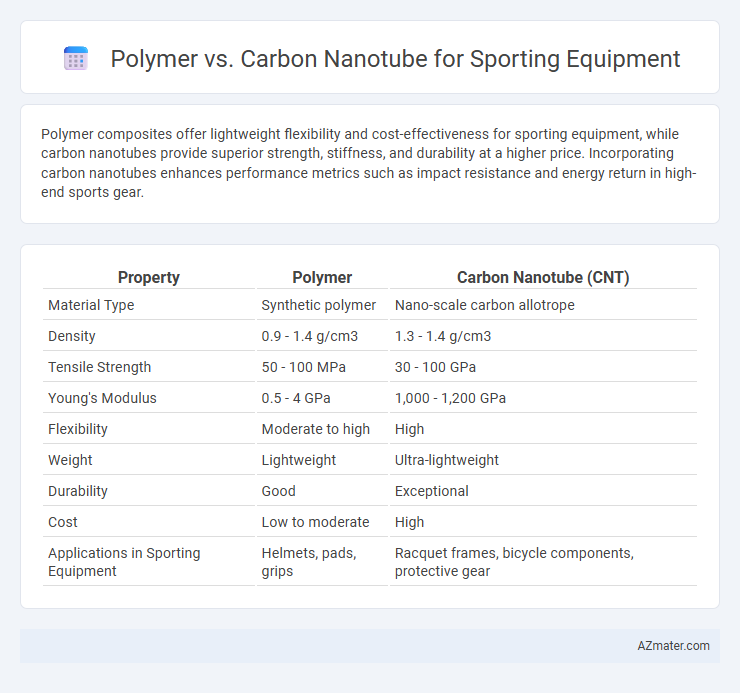Polymer composites offer lightweight flexibility and cost-effectiveness for sporting equipment, while carbon nanotubes provide superior strength, stiffness, and durability at a higher price. Incorporating carbon nanotubes enhances performance metrics such as impact resistance and energy return in high-end sports gear.
Table of Comparison
| Property | Polymer | Carbon Nanotube (CNT) |
|---|---|---|
| Material Type | Synthetic polymer | Nano-scale carbon allotrope |
| Density | 0.9 - 1.4 g/cm3 | 1.3 - 1.4 g/cm3 |
| Tensile Strength | 50 - 100 MPa | 30 - 100 GPa |
| Young's Modulus | 0.5 - 4 GPa | 1,000 - 1,200 GPa |
| Flexibility | Moderate to high | High |
| Weight | Lightweight | Ultra-lightweight |
| Durability | Good | Exceptional |
| Cost | Low to moderate | High |
| Applications in Sporting Equipment | Helmets, pads, grips | Racquet frames, bicycle components, protective gear |
Introduction: Evolution of Materials in Sporting Equipment
The evolution of materials in sporting equipment has transitioned from traditional metals to advanced composites like polymers and carbon nanotubes, enhancing performance through improved strength-to-weight ratios. Polymers offer flexibility and cost-effective manufacturing, while carbon nanotubes provide exceptional tensile strength and stiffness at minimal weight, revolutionizing the design of high-performance gear. These material innovations contribute to increased durability, responsiveness, and athlete safety across various sports applications.
Overview of Polymers in Sports Gear
Polymers such as polyethylene, polypropylene, and polyurethane are widely used in sporting equipment due to their lightweight, durability, and flexibility. These materials provide excellent impact resistance and shock absorption, making them ideal for protective gear, footwear, and flexible components of sports apparel. Advances in polymer composites enhance performance by improving strength-to-weight ratios and enabling customizable properties tailored to specific sports applications.
Carbon Nanotubes: Revolutionary Material for Performance
Carbon nanotubes (CNTs) offer unmatched tensile strength and lightweight properties, revolutionizing sporting equipment by enhancing durability and performance. Their exceptional stiffness-to-weight ratio outperforms traditional polymers, providing athletes with faster, more responsive gear that withstands intense physical stress. Incorporation of CNTs into composites leads to improved shock absorption and energy transfer, making them the material of choice for next-generation sports technology.
Weight and Strength Comparison: Polymer vs Carbon Nanotube
Carbon nanotubes exhibit exceptional tensile strength, often exceeding 60 GPa, while polymers typically range from 0.05 to 3 GPa, making nanotube composites significantly stronger for sporting equipment applications. The density of carbon nanotubes is approximately 1.3-1.4 g/cm3, lower than many traditional polymers, resulting in lighter yet more durable materials ideal for high-performance gear. Combining polymer matrices with carbon nanotube reinforcements further enhances weight-to-strength ratios, optimizing sporting equipment for both agility and durability.
Flexibility and Durability in Sports Applications
Polymer materials provide superior flexibility in sporting equipment, allowing for enhanced shock absorption and impact resistance, which benefits athletes by reducing injury risk. Carbon nanotubes offer exceptional durability with a high tensile strength-to-weight ratio, significantly extending the lifespan of gear used in high-stress activities like cycling and racquet sports. Combining polymers with carbon nanotube reinforcements results in hybrid composites that deliver both flexibility and durability, optimizing performance and resilience in competitive sports applications.
Impact on Athlete Performance and Safety
Carbon nanotubes enhance sporting equipment by providing superior strength-to-weight ratios compared to traditional polymers, resulting in lighter gear that improves athlete speed and agility. Their exceptional durability and impact resistance contribute to better energy absorption, reducing injury risk during high-impact activities. Polymers offer flexibility and cost-effectiveness but lack the advanced mechanical properties that carbon nanotubes deliver for peak athletic performance and safety.
Cost-Effectiveness and Accessibility
Polymers are widely used in sporting equipment due to their cost-effectiveness and ease of manufacturing, making them accessible for mass production and affordable for consumers. Carbon nanotubes offer superior strength-to-weight ratios and enhanced durability but come with higher production costs and limited availability, restricting their use to high-end, professional-grade equipment. The balance between polymer affordability and carbon nanotube performance drives innovation in lightweight, durable sporting goods for different market segments.
Environmental Sustainability Considerations
Carbon nanotubes offer superior strength-to-weight ratios in sporting equipment, enabling longer durability and reduced material use, which supports lower environmental impact compared to traditional polymers. Polymers, while versatile and recyclable in some cases, often rely on fossil fuel-based production and can contribute to microplastic pollution. The integration of carbon nanotubes can enhance product lifespan and reduce waste, aligning better with sustainability goals in the sports industry.
Current Trends and Innovations in Material Usage
Carbon nanotubes are increasingly integrated into sporting equipment for their exceptional strength-to-weight ratio and superior flexibility, improving performance and durability in items such as tennis rackets and golf clubs. Polymers, especially advanced thermoplastics and composites, remain popular due to their cost-effectiveness, ease of manufacturing, and ability to be engineered for specific impact resistance and elasticity. Recent innovations involve hybrid materials that combine carbon nanotubes with polymer matrices to achieve enhanced mechanical properties and vibration damping, driving the next generation of high-performance sports gear.
Future Prospects: Which Material Dominates Tomorrow’s Sports Equipment?
Carbon nanotubes offer superior strength-to-weight ratios and exceptional flexibility, making them ideal for next-generation sporting equipment demanding high performance and durability. Polymers provide cost-effective, lightweight solutions with ease of manufacturing, but their mechanical properties often lag behind nanomaterials in elite sports contexts. Future dominance in sports equipment hinges on integrating carbon nanotubes into polymer matrices, enhancing hybrid composites that combine affordability and enhanced mechanical advantages for tomorrow's innovative gear.

Infographic: Polymer vs Carbon nanotube for Sporting equipment
 azmater.com
azmater.com